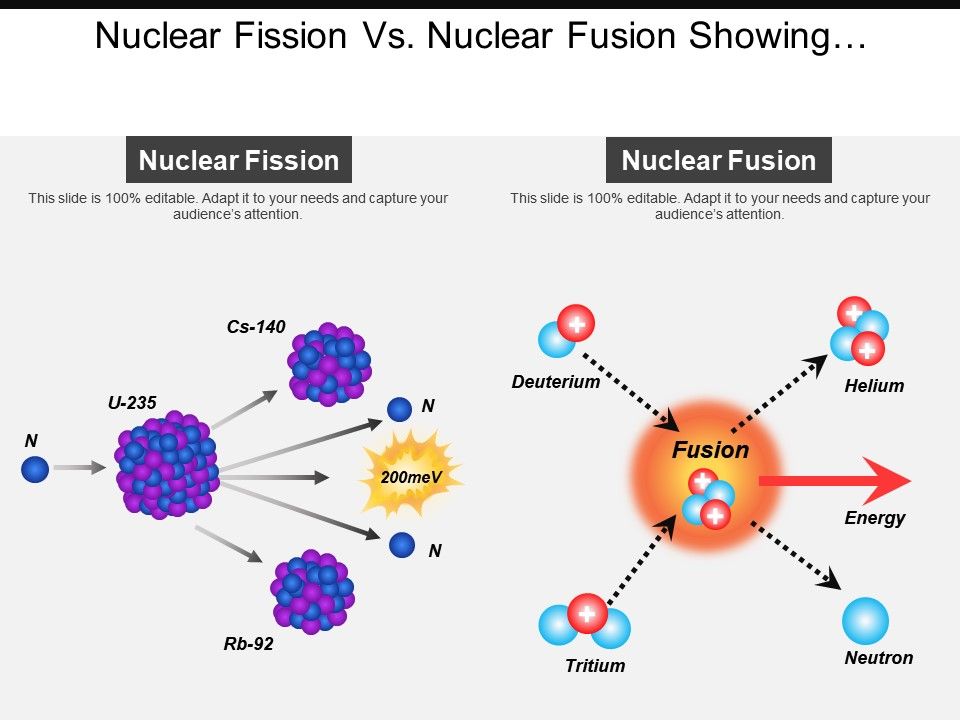


Fusion of nuclei with lower mass than iron releases energy while fusion of nuclei heavier than iron generally absorbs energy. The reaction is followed either by a release or absorption of energy. Nuclear fusion is the joining of two nuclei to form a heavier nuclei. In 2009, when work began in earnest at the National Ignition Facility, the Livermore laboratory released a video explaining its work.\( \newcommand\ J\).
DIFFERENCE IN NUCLEAR FISSION AND FUSION HOW TO
Researchers from 50 countries have been working on the problem of how to re-create and harness the energy of a fission reaction since the 1960s. In order to replicate the chemical process that powers stars in the universe, researchers at the National Ignition Facility employed the world’s most energetic lasers - 192 of them, to be exact - further compressing their intensity before shooting them into a cylinder the size of a small pebble that contained a small portion of hydrogen encased in diamond.īy blasting the hydrogen pellet with 2.05 megajoules of energy, which the New York Times noted is the equivalent of a pound of TNT, the chemical reaction was achieved, resulting in the release of 3 megajoules of energy. Learn what nuclear fission and nuclear fusion are and how you can tell them apart. (John Jett and Jake Long/Lawrence Livermore National Laboratory/Handout via Reuters) Star power Nuclear fission and nuclear fusion both are nuclear phenomena that release large amounts of energy, but they are different processes which yield different products. Laser energy is converted into X-rays inside a cylindrical shell known as a hohlraum. “Fusion could generate four times more energy per kilogram of fuel than fission (used in nuclear power plants) and nearly four million times more energy than burning oil or coal,” the IAEA says on its website. The upsides to fusion over fission have long been known to scientists. The waste byproduct of a fusion reaction is far less radioactive than in fission, and decays far more quickly. “Fusion, on the other hand, does not create any long-lived radioactive nuclear waste.” “Nuclear fission power plants have the disadvantage of generating unstable nuclei some of these are radioactive for millions of years,” the International Atomic Energy Agency states on its website. While fission and fusion both produce clean energy in terms of greenhouse gas emissions, fission comes with a glaring downside. Nuclear fission is the opposite of nuclear fusion in that the former unleashes energy by splitting heavy atoms apart. When that chemical reaction happens, it gives off energy. In order for that process to occur, the atoms must be subjected to extremely high temperatures and pressure. Nuclear fusion occurs when two atoms of a light element such as hydrogen are heated and fused together to form a heavier element such as helium. Being able to harness and replicate it means that humankind could one day tap an almost limitless source of energy that wouldn't contribute to the climate crisis caused by the burning of fossil fuels.īut what is nuclear fusion, and how did the team of scientists in California succeed in achieving what Granholm characterized as a breakthrough? Learning from the sun Nuclear fusion, after all, is the same energy that powers the sun and every other star in the universe. When Secretary of Energy Jennifer Granholm announced Tuesday that the Lawrence Livermore National Laboratory in California had successfully produced a nuclear fusion reaction that creates a net energy gain, she hailed the event as “one of the most impressive scientific feats of the 21st century.”


 0 kommentar(er)
0 kommentar(er)
